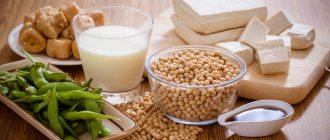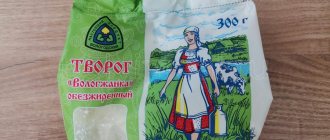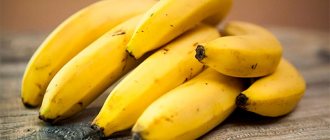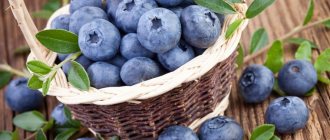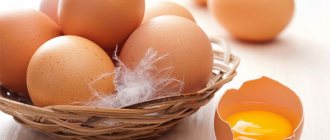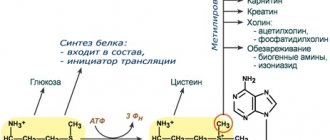If you also like to cook soybeans, you should know that they have not only positive aspects, but also some contraindications. You can find out about this in the material below.
Soy is a herbaceous crop that contains vitamins, minerals and other beneficial substances for both women and men. Soybeans can be consumed boiled, stewed, or sprouted.
Soy is considered a unique component. Other soy products are prepared from it, for example, milk, sauce, cheese, flour, and so on. All these components are part of the dietary and sports menu. That is why soybeans are valued by those people who take care of their own bodies.
Soybeans: benefits
- Soy is considered an attractive product for housewives. After all, almost any dish can be prepared from these beans.
- Soybeans have a pronounced taste and oily consistency. When spices and other components are added, the grains acquire unusual taste properties. Soybeans can be used to make soup, main course, and dessert.
Beans
Like many whole foods, soybeans have a wide range of health benefits. Among the most important, we highlight the following:
- Soybean is considered an affordable, valuable product that can be beneficial to human health. Beans contain proteins, vitamins, and minerals.
- Soybeans contain bioactive components. They prevent the risk of developing cancer.
- Soy is a fairly nutritious ingredient. But despite this, beans are considered a dietary product. They are included in many diets that help you lose weight.
- Beans do not contain harmful cholesterol , which clogs blood vessels. Soy is the product that makes blood vessels more elastic. These grains also have a preventive effect on hypertension.
- Soy milk is an affordable alternative for artificial feeding of infants for whom cow's milk is contraindicated.
- Soy is a good ingredient for those who are on a poor diet. As mentioned above, beans contain vitamins and minerals in huge quantities.
- Soybeans make delicious Tofu cheese . It can be consumed fresh, fried, pickled, smoked. It contains calcium and a small amount of calories. The cheese itself is delicious. It is recommended for use by people who have gastrointestinal diseases.
Soybean cheese
- Soy is a product that has a positive effect on fat and carbohydrate metabolism. People with diabetes should eat beans.
- Soybeans are good to add to food during fasting. They allow you to diversify the Lenten menu and provide the body with a set of necessary vitamins and minerals.
- Thanks to soy , anxiety attacks are reduced and insomnia disappears. In addition, these beans relax and improve brain functioning.
- Soybean grains normalize the intestinal microflora and have a positive effect on the skin.
- Thanks to soy, you can quickly build muscle mass , so it is useful for athletes and people losing weight.
- Soy has a positive effect on the heart and vascular system.
Benefit
Harm of soybeans. Data
1 Soy contains natural toxins
Interestingly, the Chinese did not eat unfermented soybeans like other legumes such as lentils, as soy contains large amounts of natural toxins or “antinutrients.”
Among them, first of all, trypsin inhibitors are substances that interfere with the action of the digestive enzyme trypsin, which is necessary for the digestion of proteins.
Those. It turns out that soy in its natural form contains high quality protein (with a complete amino acid profile and a high degree of digestibility) , but it is very poorly digested and absorbed .
Consumption of soybeans can cause serious gastric disorders and lead to chronic amino acid deficiency in the body with associated health consequences, since amino acids perform a wide range of important functions.
We recommend : Symptoms of protein deficiency in the body
In experiments on experimental animals that were fed food with a high content of trypsin inhibitors, an increase and development of pancreatic pathologies, including cancer, was observed [14].
Soybeans also contain a certain substance called haemagglutinin, which causes the formation of clots in the blood due to the sticking together of red blood cells.
These harmful substances in soybeans (trypsin inhibitors and hemagglutinin) are also growth inhibitors . In experiments on rats fed soy, persistent growth impairment was observed.
Share with us your experience of losing weight or gaining muscle mass!
Harmful substances in soy that interfere with normal growth and protein digestion are deactivated during the fermentation process . This is why the Chinese began to include soy products in their diet only after the discovery of the fermentation process.
During the precipitation process, enzyme inhibitors remain in the liquid and not in the curd. Thus, in tofu or bean curd, the content of harmful substances that inhibit growth and interfere with the digestion of proteins is significantly reduced, but not completely.
Soy also contains substances that disrupt the function of the thyroid gland - goitrogens, which prevent the gland from absorbing iodine.
This causes the pituitary gland to release thyroid-stimulating hormone (TSH), which leads to an increase in the size of the thyroid gland and the formation of a goiter [73].
2 Soybeans are one of the most polluted crops
In addition, a very large percentage of soy grown today (99%) is genetically modified , and also has nearly the highest degree of pesticide contamination of any food.
Have you ever wondered why soybean genes are “modified”?
Contrary to popular belief that it is done to increase crop yields or whatever, genes are manipulated to create plants that are resistant to pesticides - chemicals used to kill weeds.
Naturally, when pesticides are sprayed, they also end up on soybean plants, including beans.
Thus, in the mysterious issue of GMOs, it is not the altered genes of the beans that are scary and dangerous, but the presence of chemical contaminants in them that pose serious harm to human health.
99% of soybeans today are genetically modified and have the highest degree of pesticide contamination among agricultural crops
We recommend : The benefits and harms of milk: expert reviews
3 Soy contains phytates, which interfere with mineral absorption
Soybeans contain large amounts of phytic acid (primarily in the bran or husk of all seeds). This is a substance that blocks the absorption of important minerals in the gastrointestinal tract - calcium, magnesium, copper, iron and, especially, zinc.
Important: The effect of phytic acid has been thoroughly studied today. There are hundreds of articles in the modern scientific literature. Scientists generally agree that a diet based on grains and legumes high in phytates contributes to the development of mineral deficiency in the body [15].
Important: Research shows that calcium, magnesium, iron and zinc are present in sufficient quantities in plant foods eaten in these areas, but the high phytate content in grains and soybeans interferes with their absorption.
If you think what we do is important, support our project!
YES!
The phytate content in soybeans is one of the highest compared to any other grains or legumes [16]. They are practically not destroyed during long-term cooking , as happens in other plant products [17]. Only a long fermentation process allows them to be largely destroyed.
When precipitated soy products such as tofu are consumed with meat, the mineral blocking effect of phytates is less [18].
Important: Vegetarians who eat tofu and bean curd as a substitute for meat and dairy products are at serious risk of mineral deficiencies (calcium, magnesium, iron and zinc).
Soy contains phytates, which interfere with the absorption of minerals, leading to severe deficiencies. They do not collapse even with prolonged heat treatment
Zinc is called the “mineral for intelligence” because it is essential for optimal development and function of the brain and nervous system. It plays a role in protein synthesis; participates in the mechanism of blood sugar control, protecting against diabetes; necessary for the health of the reproductive system.
Zinc is a key component of many vital enzymes (substances that are involved in digestion) and plays an important role in the immune system. Phytates in soy products interfere with the absorption of zinc to a greater extent than other minerals [19].
Its deficiency can lead to an interesting mental disorder : a false feeling that some vegetarians may mistake for "high" spiritual enlightenment.
One likely reason why Japanese living in America grow taller than their Japanese counterparts is the consumption of cow's milk and other meat and fish products, instead of the high phytate plant foods that form the basis of their Japanese diet and have been shown to cause growth problems [20].
The harm of soy is explained by the content of certain plant substances in it - phytates and toxins, which theoretically can be removed chemically
We recommend : Soy or whey protein? Advantages and disadvantages
4 The main reason soy is harmful is isoflavones. Scientific research
Males of some species of tropical birds have a single-color (dim) color at birth, and receive colored plumage only at the time of puberty (between 9-24 months).
In 1991, Richard and Valerie James, bird breeders from New Zealand, purchased a new type of food for their birds - based on soy protein [47]. The result is that their birds reached sexual maturity (gained bright colors) after just a few months! One of the manufacturers of such food commented on this fact as one of the advantages of the food it produces.
In 1992, feeding an Australian parrot with this food, which usually acquires beautiful red plumage at 18 - 24 months, gave an amazing and at the same time frightening effect - it became red already at 11 weeks (in the 3rd month!).
In subsequent years, birds that reached early sexual maturity showed a decrease in their ability to reproduce, and those chicks that were born were deformed, stunted and often died before reaching maturity, especially among females. As a result of this, the total number of birds in the enclosure decreased.
Deformations of beaks and bones, dysbacteriosis, immune system disorders, pathologies and aggressive behavior were observed in birds. Autopsies revealed that their digestive organs were falling apart.
But something else is surprising: the list of problems was very similar to those observed in two children of researchers who were fed on soy-based formulas (!).
Read us on the networks
Frightened, the researcher hired a toxicologist to investigate further. A review of the scientific literature found numerous evidence that soy consumption is associated with numerous health problems , including infertility, an increased risk of cancer and leukemia in children, and that soy genistein provokes thyroid dysfunction in animals [48]. ].
Soy consumption has been associated with infertility, an increased risk of cancer and leukemia in children, and thyroid dysfunction.
The doctor also tested the birds' food and found that it contained high levels of phytoestrogens, especially genistein. When feeding the birds the soy protein isolate diet was stopped, the flock gradually returned to normal performance.
Scientists were clear that it was necessary to warn the public and government officials about toxins in soy products, especially isoflavones (genistein), which have detrimental effects on the endocrine system.
In 1991, Japanese researchers reported that eating just 30 grams (two tablespoons) of soybeans per day for just one month resulted in a significant increase in the secretion of a certain hormone that affects the action of the thyroid gland [49]. Other abnormalities in thyroid function were also observed, with many patients complaining of constipation, fatigue and lethargy, even if their iodine intake was adequate.
In 1997, researchers from the US National Center for Toxicological Research made the unpleasant discovery that the cause of thyroid dysfunction was the same components of soy - isoflavones [50].
Important: Now comes the fun part: 25 grams of soy protein isolate per day (the minimum amount recommended by Protein Technology International to achieve cholesterol-lowering effects) contains 50 to 70 mg of isoflavones.
For a middle-aged woman, a dose of only 45 mg of isoflavones is enough to cause disruption of the thyroid gland. Even after stopping soy consumption, the impairment persisted for three months [51].
100 grams of soy protein (the maximum recommended dose for cholesterol-lowering effects) can contain almost 600 mg of isoflavones [52]—an amount that is undoubtedly toxic .
In 1992, the Swiss Health Service estimated that 100 grams of soy protein per day provided the estrogen equivalent of hormone pills [53].
100 grams of soy protein contain the equivalent of the female sex hormone estrogen equal to one hormonal tablet
Laboratory studies have also shown that isoflavones interfere with the synthesis of steroid hormones [54], which are responsible for muscle growth .
Infertility, thyroid and liver diseases due to the consumption of soy protein (isoflavones) have been observed by researchers in several animal species, including mice, cheetahs, quail, pigs, rats, sturgeon and sheep [55].
Isoflavones are also credited with “beneficial effects” on postmenopausal symptoms in women, including mild fever, protection against osteoporosis, and more.
The degree of discomfort when the temperature rises is subjective and many studies confirm that women report a decrease in discomfort to a degree proportional to the amount of soy protein consumed [56].
The claim that soy prevents osteoporosis in general is sensational, given the fact that soy products block calcium and cause vitamin D deficiency.
If Asians do have lower rates of osteoporosis than Westerners, it is only because their diets contain more vitamin D from lard, shrimp and other seafood, and more calcium from bone broths.
The reason Westerners have such high rates of osteoporosis is that they have replaced cow butter, the traditional source of vitamin D and other fat-soluble active ingredients needed for calcium absorption, with soybean butter.
We recommend : Phytoestrogens: questionable benefits during menopause, content in products, harm. Scientific facts
5 Soy and cancer
Today in America, official bodies have adopted a resolution that prohibits any statements regarding the anti-cancer effects of the product from being placed on product packaging. But it does not in any way restrict soybean producers and marketers from propaganda in literature and on the Internet.
One brochure states: “In addition to protecting against cardiovascular disease, soy exhibits powerful anti-cancer benefits... Japanese, who eat 30 times more soy than North Americans, have lower rates of breast, uterine and prostate cancer.”[37] .
And indeed it is. But the same Japanese, and Asians in general, have much higher rates of other cancers , particularly cancers of the esophagus, stomach, pancreas, and liver [38].
Asians around the world also have high rates of thyroid cancer [39].
Based on these facts, it would be fair for those who talk about the anti-cancer effects of soy (meaning cancer of the reproductive organs) to also warn about its likely increase in the risk of cancer of the thyroid gland and digestive organs.
In order to further clarify the essence of the issue, let's find out how much soy Asians actually eat.
In 1998, one study of Japanese daily soy protein intake found: ~8 grams for men, ~7 grams for women, i.e. less than two teaspoons [40]. Another study found that legume consumption in China ranged from 0 to 58 grams per day, with a mean of about 12 grams [41].
Assuming that two-thirds of legume intake is soy, the maximum intake is about 40 grams (less than three tablespoons per day) and the average is 9 grams (less than two teaspoons).
A study conducted in 1930 found that soy products accounted for only 1.5% of the calories in the Chinese diet, but the bulk of calories (65%) came from pork [42] (Asians traditionally cook with pork fat rather than vegetable fat). butter!).
Traditionally, fermented soy products are used as a delicious natural seasoning in Asian cuisine. In times of affluence, Asians consume soy products in small quantities as seasonings, rather than as a substitute for animal products.
There are only two exceptions: times of famine and monks living in monasteries. The latter take a vow of celibacy, lead a vegetarian lifestyle, and therefore for them soy is an ideal product that also reduces libido.
We recommend : Protein and cancer: Animal protein is one of the main causes of cancer. Interview with a leading expert
One example of scientific speculation on the benefits of soy in the fight against cancer is a meta-analysis (analysis of a large number of scientific studies) conducted by Mark Messina in 1994 [43].
This scientist's conclusion is as follows: in 26 animal studies, 65% (far from 100%!) showed positive anti-cancer protective properties of soy.
However, the author somehow forgot to include at least one study in which soy feeding led to pancreatic cancer [44].
In the human studies reviewed by the author, the results were mixed: a small proportion showed some protective effect, but most showed no association at all between soy consumption and cancer incidence.
Mark Messina concluded that “ the data from his study cannot be used as a basis for the claim that soy consumption reduces the risk of cancer .”
However, in one of her books, Messina recommends eating at least one cup or 230 grams of soy products per day as "the optimal diet for cancer prevention."
Today, thousands of women consume soy in the hope that it will protect them from breast cancer.
In 1996, researchers found that women who regularly included soy protein isolate in their diet had an increased incidence of epithelial hyperplasia, a condition that precedes the development of cancer [45].
A year later, scientists found that one type of soy isoflavone, ginestein, stimulates breast cells to enter the reproduction cycle. This finding led the study authors to conclude that women should NOT consume soy products to prevent breast cancer [46].
The benefits of soy in the fight against cancer are questionable. Some studies, on the contrary, suggest that its use can stimulate the development of tumors
We recommend : Is protein harmful to health? Scientific research
6 Harmful effects of infant soy formula
In the above study of the dangerous effects of soy protein on the health of birds, as well as the children of the Jameses research family, it was soy isoflavones that were the cause.
In 1998, scientists reported that the daily dose of isoflavones in soy-based infant formulas is 6 to 11 times higher than the amount that produces hormonal disturbances in adults who consume soy products.
The concentration of isoflavones in infants fed soy-based formulas was 13,000 to 22,000 times higher than the concentration of female hormones in the blood of infants fed cow's milk formulas [57].
Important: In the United States, approximately 25% of formula-fed infants receive soy-based formula—a much higher percentage than in other parts of the Western world.
Scientists have estimated that an infant fed soy formula receives a dose of the female sex hormone (estrogen) equivalent to at least five birth control pills per day (based on body weight) [58].
In contrast, phytoestrogens were not detected in infant formula or in a mother's breast milk, even when she consumed soy products.
An infant fed soy formula receives a dose of the female sex hormone (estrogen) equivalent to five birth control pills per day (based on body weight).
It has long been known that soy infant formula can cause thyroid problems in infants. But what effect do soy products have on the hormonal development of infants, male and female?
Male children experience a “testosterone surge” during the first few months of life, when levels can be as high as those of an adult male. During this period, the child is programmed to develop male characteristics; not only the genitals and other male physical characteristics, but also certain patterns of male behavior in the brain.
In monkeys, for example, a deficiency of male hormones leads to impaired development of spatial perception (normally, it is better developed in men than in women), the ability to learn and visual recognition (important for reading, for example) [59].
Obviously, under the influence of early distortion of the hormonal environment in the infant’s body, the formation of incorrect models of future sexual orientation .
In one experiment, a male child who was “fed” during pregnancy with a synthetic analogue of the female sex hormone (estrogen), which in animals produces the same effect as soy phytoestrogens, had testes that were smaller than normal [60].
Learning disabilities, especially among male children, have reached epidemic proportions today . Feeding soy to infants, which began to gain popularity in the early 1970s, cannot be ignored as a likely cause.
What about the girls? Today, an alarming number of young women are reaching puberty much earlier than usual , according to a recent study published in the journal Pediatrics [61].
Researchers have found that 1% of all girls today show signs of puberty, such as breast development or pubic hair, by age three; by age eight, 14.7% of white girls and 50% of African-American girls aged 8 years have prominent one or both of these characteristics.
In a study in Puerto Rico, scientists in 1986 came to the unequivocal conclusion that the most likely cause of early puberty in girls is not chicken consumed as food, but soy formula for feeding infants [63].
The consequences of a “shortened” childhood are tragic. Young mature girls must struggle with strong feelings of sexual desire, for which they are not psychologically prepared.
And early maturation is often the cause of reproductive system problems later in life, including menstrual irregularities, infertility and breast cancer.
Parents of children who fed them soy formula also list other problems that appear in their children. Among them: unstable emotional behavior, asthma, immune system problems, pituitary insufficiency, thyroid disease and irritable bowel syndrome - the same endocrine and digestive abnormalities that were observed in the parrots in the experiments described above.
We recommend : The best natural fat burners and weight loss products
7 Soy protein isolate: benefits? harm? or deception?
Soy protein isolate is the result of manufacturers' persistent efforts to remove all of the harmful substances listed above. It is a key component of most soy products that mimic meat and dairy products, including infant formula and some types of soy milk.
Despite the efforts of manufacturers, they failed to create an ideal product: the harmful substances of soy are not completely removed from it, but moreover, new ones are added. See our material about the dangers of soy protein isolate.
Phytates are not completely removed from soy protein isolate
Important: Most of the harmful substances that interfere with protein digestion (inhibitors) and the absorption of minerals are removed during high-temperature processing, but not all.
Their content in the final product - soy protein isolate - can differ by 5 times from different manufacturers[21].
The protein in soy protein isolate is partially broken down
There is one more “but” in the process of obtaining soy protein isolate. During high-temperature processing (drying), partial destruction (denaturation) of the protein , and, consequently, its biological value decreases and it becomes less effective in building muscle mass [23].
It is for this reason that animals fed soy feed require additional supplementation in the form of individual amino acids (particularly lysine) for normal growth.
Soy protein isolate contains carcinogens and toxins
And that is not all. At the last step of high-temperature processing, nitrites are formed, which are strong carcinogens .
The process of alkaline processing to remove fiber is accompanied by the formation of toxins in the soy protein isolate (lysinoalanine) [24].
Soy protein isolate contains artificial flavors
In order to mask the strong characteristic taste of soybeans and impart aroma, artificial flavoring agents , particularly monosodium glutamate, are often added to soy protein isolate [25]. It is through flavoring additives that the “cow” taste of soy milk is obtained.
Soy protein isolate, despite technological processing, still contains harmful substances that interfere with protein digestion and mineral absorption; it also contains carcinogens and toxins formed during the manufacturing process, and artificial additives to improve taste and color
We recommend : Harm of sugar for humans: sugar causes cancer.
Scientific facts
The benefits of soybeans, the benefits of soybeans for women
Soybeans contain natural isoflavones. They have a positive effect on hormones. These components regulate and restore processes that are associated with the hormonal system. Negative effects in soy, however, are not observed.
Of the most important positive properties of soybeans for the female body, it is worth noting the following:
- Adding soybeans to food helps reduce the risk of malignant tumors in the mammary glands.
- Due to the presence of lecithin in beans, the amount of fat in a woman’s body decreases. Also, because of soy, less fat cells are deposited, as a result of which a woman can lose weight faster.
- Products made from soybeans have a positive effect on a woman’s condition during menopause . She no longer experiences pain caused by a lack of estrogen. Also, thanks to the consumption of soy, hot flashes disappear and the risk of osteoporosis decreases.
Beneficial for women
We must not forget that it is very useful for women to consume sprouted soybeans.
Sprouts contain protein that is good for health. At the same time, sprouts contain few calories. If you include them in your daily diet, you can cleanse your body of toxins.
Beneficial properties of soybeans
Soybean is the record holder for the content of vegetable protein; its presence in some varieties reaches 90%. Soy protein in its structure and properties is equal to protein of animal origin, due to the content of all nine amino acids necessary for the body. In terms of the amount of vegetable protein, soybeans are superior to eggs, fish, and beef.
1 kg of soybeans replaces 80 eggs or 3 kg of beef!
Soy is indicated in the diet of the following categories of people:
- vegetarians;
- raw foodists;
- people who are allergic to meat;
- patients with type II diabetes mellitus;
- women during menopause;
- fasting people;
- weight watchers and dieters.
The advantage of soy is that while animal protein increases cholesterol levels in the blood, plant protein regulates it and reduces it by 30%.
What components are contained in soybeans?
Soybeans contain a lot of protein. In addition, the culture contains the following substances:
- Fats . Beans are considered an oilseed crop. Therefore, healthy vegetable oil is prepared from them. The grains contain approximately 18% fat. Their predominant part is polyunsaturated and monounsaturated fats. Saturated fat is also present. In addition, soy contains linoleic acid. Its share of fat content is approximately 50%.
- Carbohydrates . Soybeans contain some carbohydrates. In addition, the culture has a low glycemic index. It affects blood glucose levels after meals. This is why a lower GI allows people with diabetes to consume beans.
- Cellulose . Beans contain soluble and insoluble fiber. The latter sometimes causes flatulence and diarrhea. Therefore, soy is not recommended for sensitive people. Alpha-galactosides are dietary fibers that increase the symptoms of irritable bowel disease. Soluble fiber helps build bacteria in the large intestine. As a result, fatty acids appear that improve intestinal function and reduce the risk of colon cancer.
- Molybdenum . Beans contain a lot of this substance. This is an important trace element that is present in soybean seeds and grains.
- Vitamin K1. It has a positive effect on blood clotting.
- Folate . Performs various functions, especially important for pregnant women.
- Copper . Positively affects the functioning of the heart.
- Phosphorus . This is an important element that must be present in every person’s diet.
- Thiamine . Positively affects the functions of many organs.
- Isoflavones . They affect the functioning of organs and the general condition of a person. There are a lot of these components in soy. Thanks to them, estrogen is formed in a woman’s body.
- Phytic acid. If you eat beans in a boiled and sprouted state, the absorption of many minerals improves.
- Saponins . These components reduce the amount of cholesterol in the body.
Components
Soy - cooking recipes
A huge number of dishes can be made from the plant and its derivatives: first courses, second courses, side dishes, salads, desserts. Almost all of them are perfect for dietary and vegetarian meals. When choosing dishes, take into account that soy is best combined with vegetables and grains. During the cooking process, you can safely add seasonings, spices, sauces and other ingredients to enrich the taste.
Syrniki
- Time: 35 minutes.
- Number of servings: 4 persons.
- Calorie content of the dish: 200 kcal (per 100 g).
- Purpose: breakfast, dessert.
- Kitchen: homemade.
- Difficulty: easy.
Syrniki are made from tofu, which is similar in structure to cottage cheese. This is a great option for a light and healthy diet breakfast. The cheesecakes turn out fluffy and rosy. They should appeal not only to adults, but also to children. According to the recipe, wheat flour is added to the dish, but you can use half the soy flour. In this case, do not put eggs in the dough.
Ingredients:
- vegetable oil – 2 tbsp. l.;
- tofu – 400 g;
- wheat flour – 7-8 tbsp. l.;
- eggs – 2 pcs.;
- vanillin – 0.5 g;
- sugar – 3 tbsp. l.
Cooking method:
- Pat the tofu dry. If it is frozen, then first bring it to room temperature and squeeze it out.
- Grate the tofu on a fine grater.
- Add eggs. Mix thoroughly.
- Add sugar, vanillin.
- Gradually add flour. Depending on how wet the tofu is, you may need less than what the recipe calls for.
- Knead the dough so that it holds its shape well.
- Form flat cheesecakes. Roll in flour.
- Heat the oil in a frying pan. Fry the cheesecakes for 2-3 minutes on each side.
Cutlets
- Time: 1 hour.
- Number of servings: 6 persons.
- Calorie content of the dish: 195 kcal (per 100 g).
- Purpose: main dish.
- Kitchen: homemade.
- Difficulty: medium.
Beans can be used to make wonderful cutlets, low in calories and very nutritious. You can serve them with mashed potatoes, rice, buckwheat. If you are on a diet, then make a simple vegetable salad as a side dish. The cutlets are suitable for those who are fasting; they contain all the products allowed for this period. The recipe is not too complicated, any housewife can master it.
Ingredients:
- soybeans – 2 cups;
- flour – 4 tbsp. l.;
- onion – 4 medium heads;
- dried ginger - a couple of pinches;
- garlic – 6 cloves;
- salt, pepper - to taste;
- potatoes 4 medium tubers.
Cooking method:
- Sort the beans and soak overnight. In the morning, rinse, cover with clean water and cook until soft.
- Peel the vegetables. Cut into pieces. Fry two onions in vegetable oil.
- Combine beans, potatoes, garlic. Add onions, both raw and fried.
- Pass the products through a meat grinder or grind with a blender.
- Add spices. You can add some chicken seasoning. Mix the minced meat thoroughly.
- Heat a frying pan with oil. Form cutlets. Roll in flour.
- Fry the cutlets until golden brown on both sides.
Soybean soup
- Time: 45 minutes.
- Number of servings: 4 persons.
- Calorie content of the dish: 153 kcal (100 g).
- Purpose: first course, lunch.
- Cuisine: oriental.
- Difficulty: easy.
Soybean soup is an easy dietary first course. Prepared quickly from the simplest ingredients. A serving of this soup for lunch will help you not get hungry until late in the evening. It should be cooked in vegetable broth, but meat broth can also be used. Experiment by adding different seasonings, dried herbs, and spices to the soup. This way you can change the taste of the dish to suit your preferences.
Ingredients:
- soybeans – 2 cups;
- spices, salt, pepper;
- potatoes – 10 pcs.;
- vegetable broth – 4 l;
- onions – 2 pcs.;
- wheat flour – 2 tbsp. l.;
- butter – 1-2 tbsp. l.
Cooking method:
- Soak the beans overnight. In the morning, rinse and cook until soft.
- Peel the onion. Grind. Fry until golden brown in butter. Add flour and a little broth. Rub until all lumps disappear.
- Add onion dressing to the heated broth. Add beans.
- Half an hour after boiling, add peeled and diced potatoes.
- Cook the soup for another half hour. Before turning off, add salt and seasonings. You can add a little soy sauce.
How do soybeans fight cancer?
- Soybeans are recommended for consumption by people who have survived or are suffering from cancer. Beans contain active substances that fight tumors. One of these components is genestein . It binds to estrogens and partially blocks the pathogenic qualities of estrogen. As a result, the development of cancer cells that depend on estrogen is reduced. For example, during cancer of the mammary glands and ovaries.
- Genestein contacts testosterone receptors. It slows down the development of prostate cancer.
- Genestein also has other positive properties. Thanks to the substance, the development of antigenesis and enzymes that are involved in the formation and rapid growth of cancer cells is inhibited. Therefore, it is believed that these qualities of genistein are involved in the fight against a variety of cancers.
Contraindications for use
There are categories of people who need to eat soy products with caution or are strictly prohibited. Even a completely healthy person is not recommended to consume more than 150-200 g per day and avoid genetically modified beans. People with diabetes or obesity are allowed to eat soy in minimal quantities. Categorical contraindications:
- pregnancy;
- childhood;
- diseases of the endocrine system;
- individual intolerance;
- young age of women and men.
The benefits of soybeans for weight loss
- The soybean diet is a great way to lose weight. Thanks to this technique, you can quickly lose extra pounds and make your muscles more toned.
- The main feature of losing weight on soy dishes is that each product contains a lot of protein. It is thanks to him that muscles are tightened and strengthened.
The uniqueness of the soy diet is that the beans contain phytoestrogen and lecithin. These are biologically active components, thanks to which fat cells are burned faster, metabolic processes are improved, and the amount of cholesterol is reduced.
Soy is used for diet
The soy diet has its own advantages:
- Dishes made from beans reduce weight faster than meat and dairy products.
- By regularly consuming soy and combining such nutrition with physical activity, you can strengthen muscle mass and become slimmer.
The soy diet also has some disadvantages. For example, soy products can cause allergies . In addition, pregnant women should not eat soy.
Let us note that thanks to soy products you can lose up to 7 kg in one week, while the calorie content of your daily diet should be no more than 1300 Kcal. During the diet, you must avoid sweets, smoked, flour, fried and fatty foods.
Harm and dangerous consequences
Consuming any product in excess can lead to health problems. What harm can soy cause to the body:
- The product has a goitrogenic effect. The substances contained in it can provoke disruption of the thyroid gland and endocrine system. This causes the formation of goiter, thyroiditis and other diseases.
- The composition contains oxalic acid, which contributes to the development of urolithiasis.
- Excessive consumption of soy products can cause hypertrophy of the pancreas and impair its functioning.
- The enzymes contained in the product slow down the process of absorption of calcium, zinc, iron, iodine from other foods.
- Soy phytoestrogens can disrupt the functioning of the female reproductive system, although they are considered beneficial. They can cause menstrual irregularities, accelerated development in girls, and problems with childbirth. During pregnancy, they increase the risk of miscarriage and can cause fetal development defects. Phytoestrogens are also unsafe for men. Their excess causes female obesity, decreased potency, and delayed development in boys.
- The substances contained in the product accelerate the progression of Alzheimer's disease and senile dementia.
Genetically modified soybeans
It's sad, but such a product and derivatives are found on the market very often. Eating genetically modified soy is dangerous. Her genes are artificially changed by inactivation so that the plant does not respond to herbicide treatment. The consequences of eating products made from such raw materials have not yet been fully studied. It has been precisely confirmed that genetically modified soybeans do not have beneficial properties and cause obesity and allergic reactions.
Soybeans: contraindications
- Soybeans sometimes cause an allergic reaction. This is especially true for small children. Babies may experience skin rashes and hives.
- Soy contains very little tyramine. Because of this substance, migraines may intensify in those patients who are prone to this disease.
- Soy contains phytoestrogens . They are very similar to female sex hormones. These substances sometimes provoke the development of neoplasms in those people who suffer from pathologies and diseases related to the reproductive system.
- Soy should not be consumed by people who have thyroid dysfunction.
- In large quantities, soy can have a negative effect on the male body. Beans may reduce sperm concentration.
May be dangerous
- Genetically modified soybeans, like other similar products, have negative properties. But this has not been scientifically proven. Soybean grains are particularly susceptible to modified changes. American companies were able to demonstrate this. That is why people who care about their own health should not consume products produced by foreign manufacturers, and also refuse fast food, like at McDonald's.
I would also like to add that soy products are the main basis of the cuisine of Asian countries. But the locals there do not suffer from serious illnesses. The population in Asia is growing rapidly, so life expectancy here is not considered critical.
Soy products
Currently, a large number of products are produced from soybeans:
- Soy flour is a complete replacement for eggs and is usually used as a dough thickener in vegetarian baking.
- Soybean oil - used as a substitute for other vegetable oils.
- Soy sauce is a popular seasoning for Asian dishes.
- Soy milk - used as a replacement for cow's milk.
- Natto - fermented soybeans - is the basis of the Japanese breakfast.
- Yuba is dried foam collected from soy milk.
- Tofu is a traditional Japanese cheese made from soy milk.
Harm of soybeans: dispelling myths
As you noticed, there is as much harm in soybeans as in any other ordinary product. But why are soy considered harmful? For what reasons have people stopped loving her lately?
The following myths exist:
Myth No. 1
- Soybeans are considered by many to be a genetically modified plant. And in vain. There was one ban in our country. It said that it was impossible to grow such a crop on a large scale and use it in food. This ban is still in effect today.
- Soybeans, which are found in our country, are a natural crop , they are not genetically modified. In addition, a law has been adopted on fines for growing hybrid soybeans without special permission.
- Therefore, Russian consumers do not have to worry about getting bad beans. Let us note that domestically produced soybeans are completely safe and environmentally friendly.
Some people think soy is hazardous to health
Myth #2
- Soy has a very high binding quality , so it can retain moisture in foods. Many food manufacturing companies use beans to make sausages, semi-finished products, and pates. They add soy to their own products in large quantities.
- However, buyers want to pay for meat, but not for soybeans. Let us note that soy is added to all products that contain monosodium glutamate, as well as flavorings. This makes additives more difficult to detect.
- Soybeans are used in bakeries. Grains are added to make the bread crust crispier. And into a cracker to make the cookies crispy.
- Therefore, if you do not want to include soybeans in your diet, consider our advice. But let us note once again that the harm from this crop is less than from chemical additives.
Background of soybean cultivation
Soybean is a plant of the legume family, brought to us from China and India, where it has been grown for at least 5 thousand years. In Russia, this unpretentious plant began to be grown en masse and used in food production since the 70s of the last century. Our soybeans are grown in the Far East - Primorsky Territory, there are fields in the Stavropol and Krasnodar Territories, where there is a lot of moisture, heat and fairly long daylight hours. We export most of the soybeans, using little of it in the production of our own food products.
Soybeans: reviews
People who consume soy have different opinions about it. Some people like soybeans, others consider them harmful.
- Maria, 57 years old: “If you abuse soy, it, of course, can do a lot of harm. This once again proves that all foods should be eaten in moderation. I studied a lot of articles about the benefits of soybeans. Soy is especially useful for women during menopause. I buy soybeans in grains or ready-made products from it. This is because I try to eat exclusively healthy foods, but at the same time I control the amount of soy in my diet. I advise everyone to eat these beans. But before that, it is advisable to carefully study the contraindications.”
- Leonid, 45 years old: “I love eating soy and products made from it. I especially like sprouted beans and Tofu cheese. In salads and other dishes that do not require heat treatment, I add soy sauce instead of salt. It is healthier than salt itself.”
- Svetlana, 37 years old: “Soy is a completely harmless product. Of course, if these beans are eaten every day in large quantities, the body may malfunction. Keep this in mind when you decide to include soybeans in your diet.”
- Sergey, 62 years old: “Many people believe that soy is a harmful product. But it has been proven that constant consumption of soy helps to lose weight and get rid of vascular and heart diseases. The most important thing is that you don’t come across genetically modified soybeans in the store. She is harmful. And from beans that are grown without genetic changes, you can prepare very tasty dishes, even at home. Salads, soups, and cereals are especially delicious.”
Composition and benefits of the product
Dry soybeans
are a high-protein product that is also quite high in calories - 100 grams of dried soybeans account for 440 kilocalories. In terms of protein content, soybeans are superior to beans, peas and other legumes.
Composition of the product:
- Protein – about 37 grams;
- Fats – 20 g;
- Carbohydrates – 30 g, including sugar – 7 grams.
Therefore, it is important to eat soybeans as an energy-rich and high-protein product. And, of course, the benefits of soy products containing healthy fatty acids speak of soy as an exceptional product for women's health, beauty of hair, nails, and youthful skin. And the presence of fiber makes the product indispensable for diabetics and anyone who wants to lower cholesterol.
The presence of beneficial minerals and vitamins in beans brings soy even closer to an ideal product for everyone, although there are exceptions, and we will talk about contraindications a little later. And now we propose to study the vitamin composition of mature soybeans.
Content of vitamins and minerals (100 grams of mature soybeans):
- Retinol (Vit. A) – 1 mcg
- Pyridoxine (B6) - 0.40 mg
- Vitamin B9 - 375 mcg
- Vitamin C 6 mg
- Calcium about 280 mg
- Iron contains about 16 mg
- Magnesium – 290 mg
- Phosphorus – 705 mg
- Record amount of potassium - 1797 mg
- Sodium about 3 mg
- Zinc – 5 mg
Based on the composition of the product, we see that the product is indispensable for heart patients and people suffering from vascular diseases. It strengthens bones due to its phosphorus content and prevents osteoporosis. Due to the presence of magnesium, the product is useful for nervous disorders. And the content of isoflavones, phytosterols and phospholipids has a beneficial effect on the female body.
It is known that in the USA they have been producing soybean products for years, but they do not use the beans as food. Only the fat is extracted from them, and then the cake is used for further processing. Soybean oil is used to prepare dietary dishes. The cake is very rich in protein, so soy meat and other products are produced from it. The cake is also fed to animals.
Naturally, when people buy, for example, sausage or dumplings, they do not suspect that, in fact, they will be eating products containing soy, is this good or bad? There is no harm in the product if it has been tested by a laboratory. This does not mean that GMOs are present in every package of soy meat or milk. But still, when choosing a product as food, you should pay attention to the manufacturer and trust trusted companies.
Asians eat soybeans with iodine-containing foods - vegetables, seaweed, seafood ... That's why the Japanese look healthier and feel more energetic, and it's not for nothing that Japan is considered a country of long-livers.
Soy products
Soy products, beans
Are you interested in the question of which products contain soy most often? The best foods containing soy :
- tofu cheese,
- Soy meat,
- soy milk,
- yoghurts,
- soy sauce,
- soybean oil,
- soy flour.
Soybeans are also added to food products such as cutlets, dumplings, sausages, etc. If you are interested in soy products, where to buy them, they are sold in sports nutrition stores and on supermarket shelves among products for diabetics.
Soybean is very popular in India, a variety of dishes are prepared from it, and Indians are always cheerful and healthy, because their diet already includes healthy beans.
Indian dish made from pieces of soy meat, coconut milk, spices and vegetables.
In Japan and China, soybeans are also very popular; they prepare numerous dishes from it. They also use milk, a soy drink; the benefits of soy products are highly valued there. Soybeans are used to prepare various sauces, pastes, and soups. In the USA and Indonesia, a popular dish is called "Tempe", and in Japan - "Edamame" - these are boiled green soybean pods, soy flour, butter, fuju (milk film), natto, and soy sauce are also used.
As you can see, soy appears quite often in food products. And dishes made from it are very healthy and tasty. In Japanese everyday life, misu soup is generally considered a panacea for all diseases, and in this the Japanese differ from the Europeans - they are healthier and stronger every year.
Soy protein - benefits and harms
If we consider soybeans from a nutritional point of view, they are superior to beans in protein content (per 100 grams of beans there are 23 g of protein, and soybeans - 37 g). And protein, as is known, is a unique building material for the cells and blood of the human body . And this is not a simple protein, but a textured plant protein that helps people with various diseases if they are allergic to animal protein.
Also, due to its protein content, and the benefits of soy proteins are underestimated, soy perfectly saves athletes from overload and helps build muscle mass. For those trying to lose weight, soy protein also helps improve their diet.
Soy controls weight
Soybeans exhibit a two-way effect in that consumption of the product helps those who want to gain a few kilograms and lose weight, and those who want to lose weight. This is surprising, but true. For diabetics, this is a big plus - soy is very nutritious, at the same time, phytosterols help lower cholesterol levels by blocking its absorption by the body.
Fiber does an excellent job of moving food through the gastrointestinal tract, which is why soy is recommended for constipation. In addition to improving digestion, fiber helps prevent colon cancer.
For heart health
Thanks to its record potassium content, soy controls heart attacks, and dietary fiber in large quantities scrapes cholesterol from the walls of capillaries and strengthens blood vessels. Linoleic and lanolinic acids also affect smooth muscles and help lower blood pressure.
Soy also acts as a sedative because it contains folic acid and magnesium. These elements are directly related to the human nervous system. If you have mood swings or simply fall asleep for a long time, it is better to replenish your body's reserves with soy.
The effect of soy on men's health
Is soy harmful to the male body? Soy products contain isoflavonoids, plant compounds similar to female hormones. For men, the use of these substances is undesirable; in large quantities, they can suppress male hormones and impair testosterone production.
You will like the article: “ Soy sauce – health benefits and harms for men and women .”
Soy products cause disruption in the production of hormones in the thyroid gland and prevent the penetration of iodine into the body. What do these processes lead to?
Consequences:
- Slow metabolism;
- Decreased performance of the body;
- Decreased hormone production.
Beans contain polyunsaturated fatty acids that oxidize in the body and damage it at the cellular level. This is how hormonal disruption occurs, and therefore men are not recommended to abuse products containing soy.
Soy in cosmetology
In cosmetology, a protein compound obtained by hydrolysis of soy flour is widely used. How is soy protein used?
Application:
- They have a positive effect on damaged hair, have a conditioning, moisturizing and restoring effect.
- Penetrate the skin, smooth out wrinkles and prevent premature aging, thanks to soy isoflavones.
- They take care of the eyelids, eliminating swelling and dark circles under the eyes. There are many serums and creams in which soy is the main component.
- Used in the care of rough and rough areas of the skin of the hands and feet (heels, elbows). They have a bright softening and moisturizing effect, and are able to eliminate dermatological defects on the skin.
Soybean oil is widely used; it is suitable for skin types such as dry and normal, as well as those with the first signs of aging. It is not recommended to use oil for oily epidermis.


